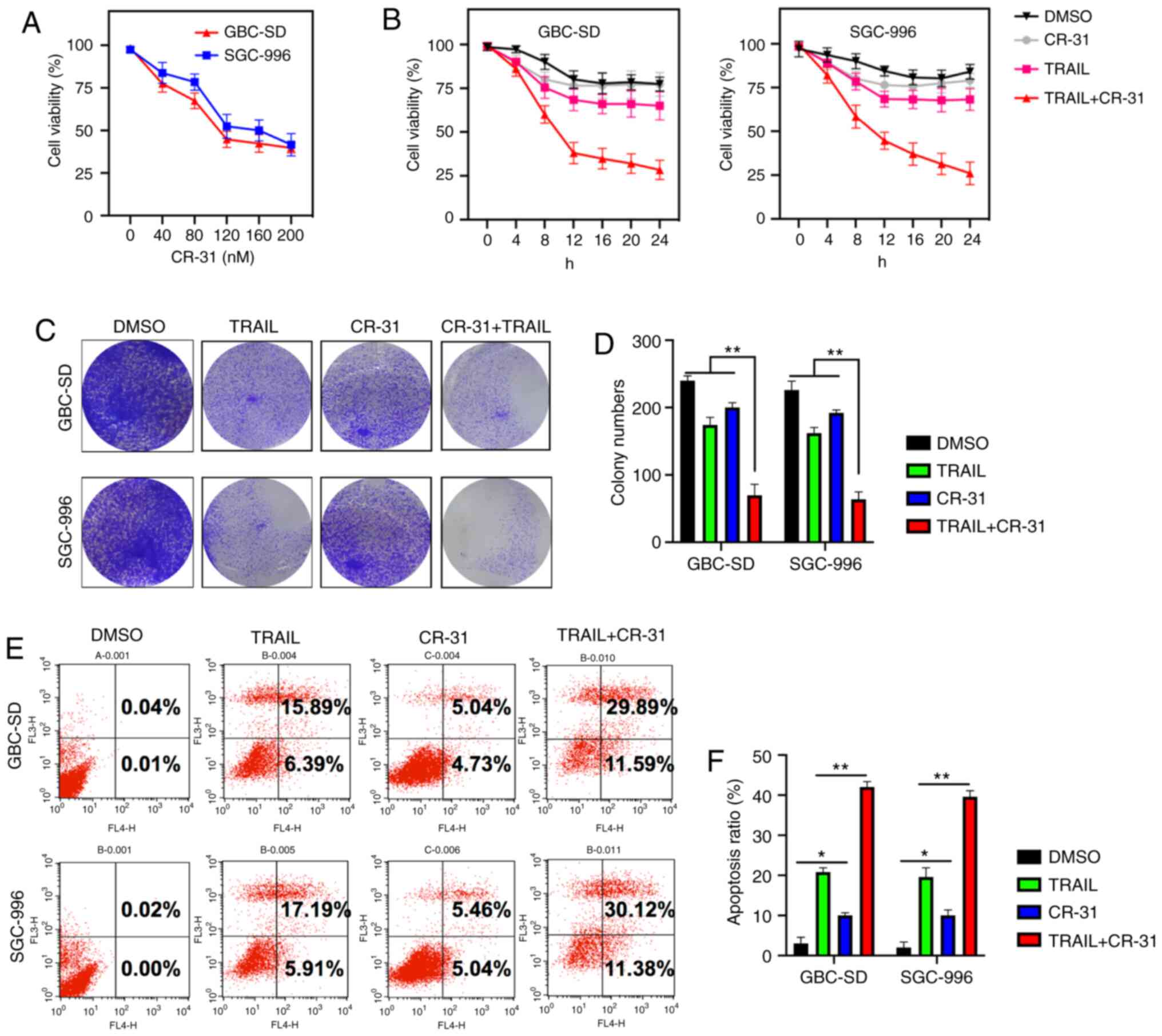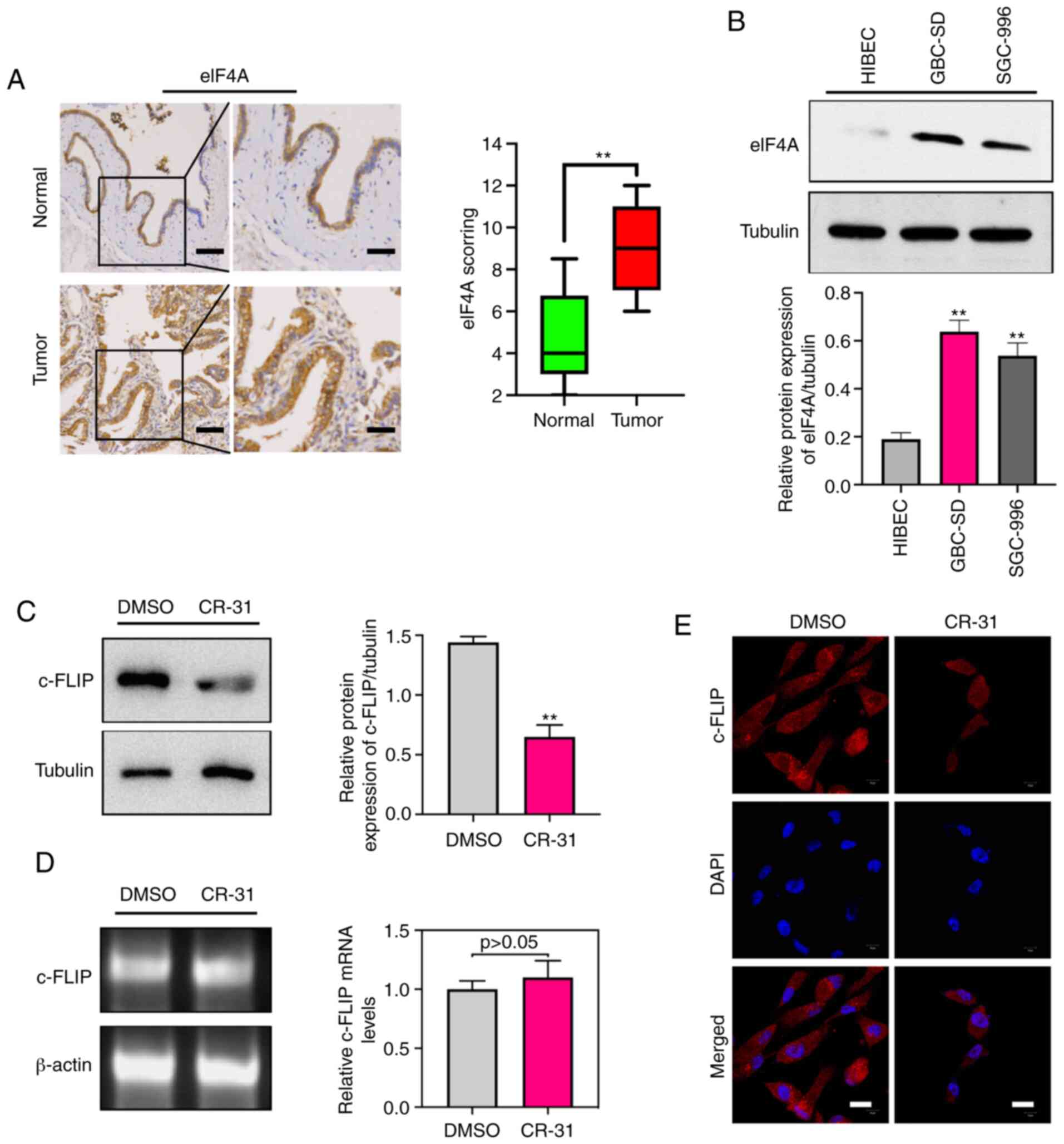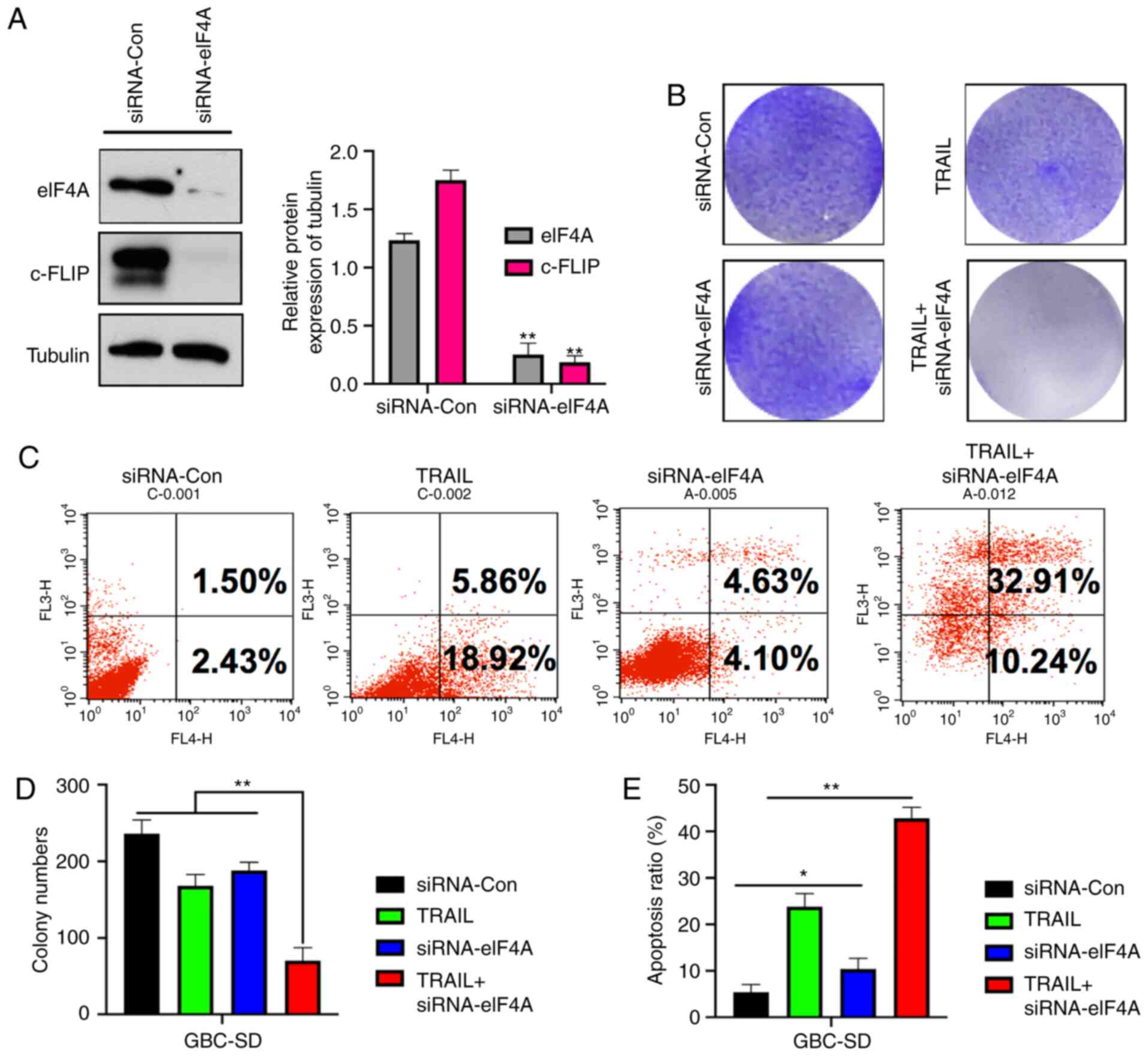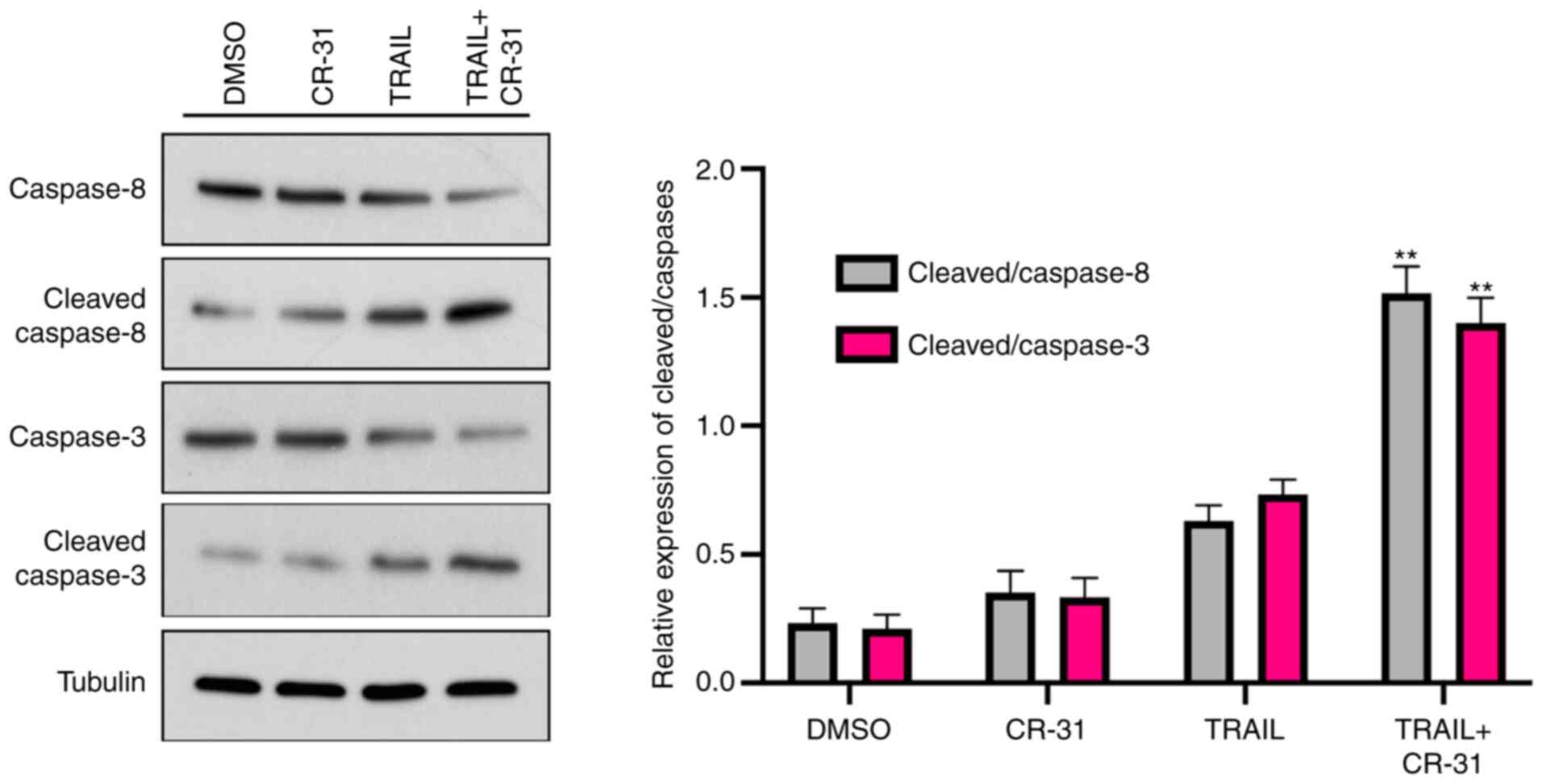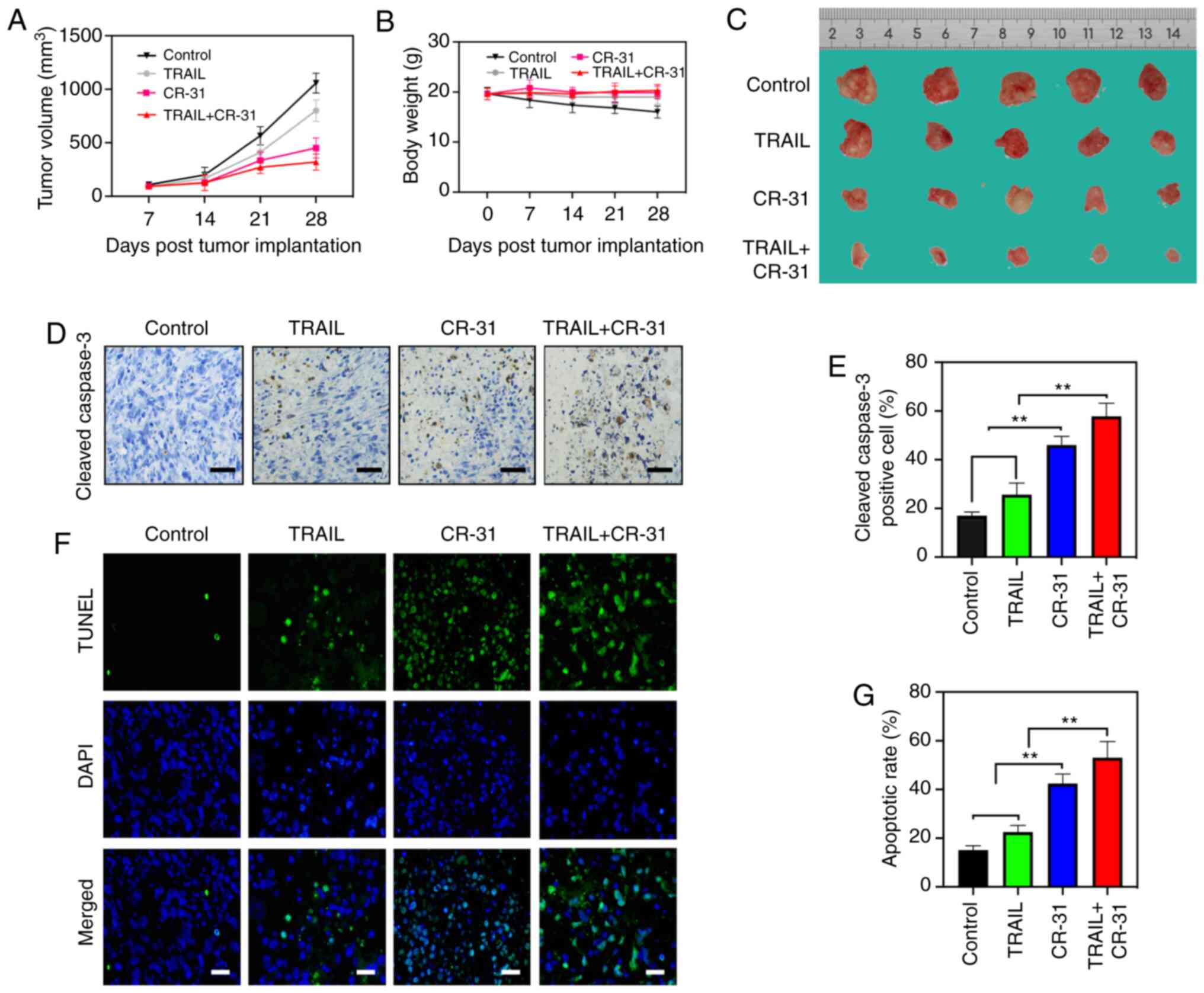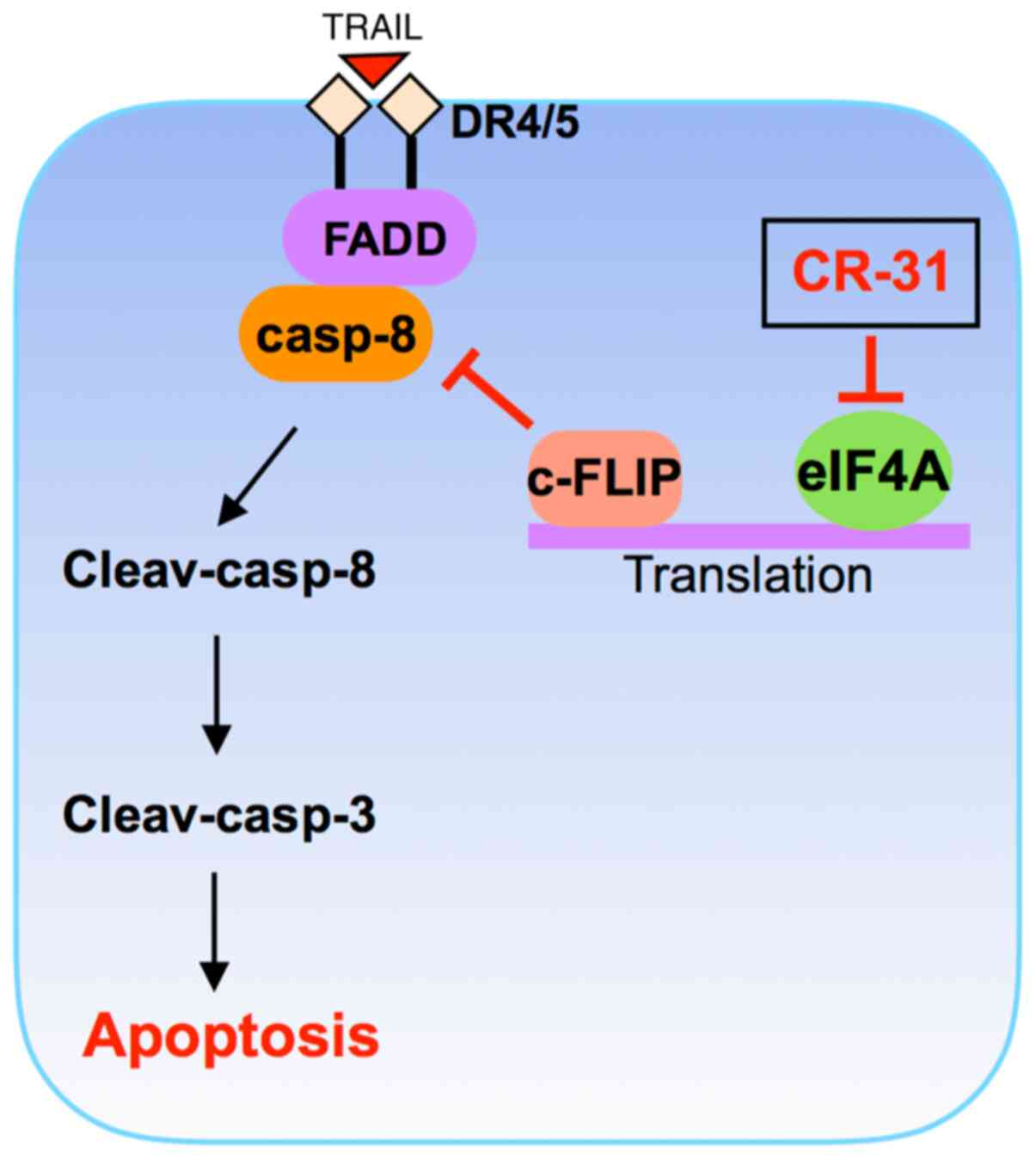|
1
|
Baichan P, Naicker P, Devar JWS, Smith M,
Candy GP and Nweke E: Targeting gallbladder cancer: A pathway based
perspective. Mol Biol Rep. 47:2361–2369. 2020. View Article : Google Scholar
|
|
2
|
Maurya SK, Tewari M, Mishra RR and Shukla
HS: Genetic aberrations in gallbladder cancer. Surg Oncol.
21:37–43. 2012. View Article : Google Scholar
|
|
3
|
Henry CM and Martin SJ: Caspase-8 acts in
a non-enzymatic role as a scaffold for assembly of a
pro-inflammatory ‘FADDosome’ complex upon TRAIL stimulation. Mol
Cell. 65:715–729.e5. 2017. View Article : Google Scholar
|
|
4
|
Merino D, Kelly GL, Lessene G, Wei AH,
Roberts AW and Strasser A: BH3-mimetic drugs: Blazing the TRAIL for
new cancer medicine. Cancer Cell. 34:879–891. 2018. View Article : Google Scholar
|
|
5
|
Zhu W, Zhan D, Wang L, Ma D, Cheng M, Wang
H, Zhao J, Cai Y and Cheng Z: Proteasome inhibitor MG132
potentiates TRAIL-induced apoptosis in gallbladder carcinoma GBC-SD
cells via DR5-dependent pathway. Oncol Rep. 36:845–852. 2016.
View Article : Google Scholar
|
|
6
|
Srivastava K, Srivastava A and Mittal B:
Caspase-8 polymorphisms and risk of gallbladder cancer in a
northern Indian population. Mol Carcinog. 49:684–692. 2010.
|
|
7
|
Zong H, Yin B, Chen J, Ma B, Cai D and He
X: Over-expression of c-FLIP confers the resistance to
TRAIL-induced apoptosis on gallbladder carcinoma. Tohoku J Exp Med.
217:203–208. 2009. View Article : Google Scholar
|
|
8
|
Bhat M, Robichaud N, Hulea L, Sonenberg N,
Pelletier J and Topisirovic I: Targeting the translation machinery
in cancer. Nat Rev Drug Discov. 14:261–278. 2015. View Article : Google Scholar
|
|
9
|
Iwasaki S, Floor SN and Ingolia NT:
Rocaglates convert DEAD-box protein eIF4A into a sequence-selective
translational repressor. Nature. 534:558–561. 2016. View Article : Google Scholar
|
|
10
|
Chu J, Zhang W, Cencic R, Devine WG,
Beglov D, Henkel T, Brown LE, Vajda S, Porco JA Jr and Pelletier J:
Amidino-rocaglates: A potent class of eIF4A inhibitors. Cell Chem
Biol. 26:1586–1593.e3. 2019. View Article : Google Scholar
|
|
11
|
Langlais D, Cencic R, Moradin N, Kennedy
JM, Ayi K, Brown LE, Crandall I, Tarry MJ, Schmeing M, Kain KC, et
al: Rocaglates as dual-targeting agents for experimental cerebral
malaria. Pro Natl Acad Sci USA. 115:E2366–E2375. 2018. View Article : Google Scholar
|
|
12
|
Rodrigo CM, Cencic R, Roche SP, Pelletier
J and Porco JA: Synthesis of rocaglamide hydroxamates and related
compounds as eukaryotic translation inhibitors: Synthetic and
biological studies. J Med Chem. 55:558–562. 2012. View Article : Google Scholar
|
|
13
|
Luan Z, He Y, Alatar M, Chen Z and He F:
Targeting the prohibitin scaffold-CRAF kinase interaction in
RAS-ERK-driven pancreatic ductal adenocarcinoma. Mol Cancer.
13:382014. View Article : Google Scholar
|
|
14
|
Collisson EA, Trejo CL, Silva JM, Gu S,
Korkola JE, Heiser LM, Charles RP, Rabinovich BA, Hann B, Dankort
D, et al: A central role for RAF-MEK-ERK signaling in the genesis
of pancreatic ductal adenocarcinoma. Cancer Discov. 2:685–693.
2012. View Article : Google Scholar
|
|
15
|
Kong X, Luo J, Xu T, Zhou Y, Pan Z, Xie Y,
Zhao L, Lu Y, Han X, Li Z and Liu L: Plumbagin enhances
TRAIL-induced apoptosis of human leukemic Kasumi-1 cells through
upregulation of TRAIL death receptor expression, activation of
caspase-8 and inhibition of cFLIP. Oncol Rep. 7:3423–3432. 2017.
View Article : Google Scholar
|
|
16
|
Hayakawa Y, Screpanti V, Yagita H,
Grandien A, Ljunggren HG, Smyth MJ and Chambers BJ: NK cell TRAIL
eliminates immature dendritic cells in vivo and limits dendritic
cell vaccination efficacy. J Immunol. 172:123–129. 2004. View Article : Google Scholar
|
|
17
|
Rawla P, Sunkara T, Thandra KC and Barsouk
A: Epidemiology of gallbladder cancer. Clin Exp Hepatol. 5:93–102.
2019. View Article : Google Scholar
|
|
18
|
Wu K, Huang J, Lin N, Xu T, Cai W and Ye
Z: Antitumor effect of ginsenoside Rg3 on gallbladder cancer by
inducing endoplasmic reticulum stress-mediated apoptosis in
vitro and in vivo. Oncol Lett. 16:5687–5696. 2018.
|
|
19
|
Song X, Wang Z, Liang H, Zhang W, Ye Y, Li
H, Hu Y, Zhang Y, Weng H, Lu J, et al: Dioscin induces gallbladder
cancer apoptosis by inhibiting ROS-mediated PI3K/AKT signalling.
Int J Bio Sci. 13:782–793. 2017. View Article : Google Scholar
|
|
20
|
Chu J, Galicia-Vázquez G, Cencic R, Mills
JR, Katigbak A, Porco JA Jr and Pelletier J: CRISPR-mediated
drug-target validation reveals selective pharmacological inhibition
of the RNA helicase, eIF4A. Cell Rep. 15:2340–2347. 2016.
View Article : Google Scholar
|
|
21
|
Zhang W, Chu J, Cyr AM, Yueh H, Brown LE,
Wang TT, Pelletier J and Porco JA Jr: Intercepted retro-nazarow
reaction: Syntheses of amidino-rocaglate derivatives and their
biological evaluation as eIF4A inhibitors. J Am Chem Soc.
141:12891–12900. 2019. View Article : Google Scholar
|
|
22
|
Tsumuraya T, Ishikawa C, Machijima Y,
Nakachi S, Senba M, Tanaka J and Mori N: Effects of hippuristanol,
an inhibitor of eIF4A, on adult T-cell leukemia. Biochem Pharmacol.
81:713–722. 2011. View Article : Google Scholar
|
|
23
|
Nazim UM and Park SY: Attenuation of
autophagy flux by 6-shogaol sensitizes human liver cancer cells to
TRAIL-induced apoptosis via p53 and ROS. Int J Mol Med. 43:701–708.
2019.
|
|
24
|
Min KJ, Han MA, Kim S, Park JW and Kwon
TK: Osthole enhances TRAIL-mediated apoptosis through
downregulation of c-FLIP expression in renal carcinoma Caki cells.
Oncol Rep. 37:2348–2354. 2017. View Article : Google Scholar
|
|
25
|
Hughes MA, Powley IR, Jukes-Jones R, Horn
S, Feoktistova M, Fairall L, Schwabe JW, Leverkus M, Cain K and
MacFarlane M: Co-operative and hierarchical binding of c-FLIP and
caspase-8: A unified model defines how c-FLIP isoforms
differentially control cell fate. Mol Cell. 61:834–849. 2016.
View Article : Google Scholar
|
|
26
|
Huang Y, Yang X, Xu T, Kong Q, Zhang Y,
Shen Y, Wei Y, Wang G and Chang KJ: Overcoming resistance to
TRAIL-induced apoptosis in solid tumor cells by simultaneously
targeting death receptors, c-FLIP and IAPs. Int J Oncol.
49:153–163. 2016. View Article : Google Scholar
|
|
27
|
Zong H, Zhou H, Xiang Y and Wu G: miR-125b
suppresses cellular proliferation by targeting c-FLIP in
gallbladder carcinoma. Oncol Lett. 18:6822–6828. 2019.
|
|
28
|
Su W, Jiang X, Chen M, Huang M, Tang N,
Wang X, Li X, She F and Chen Y: cIAP1 promotes proliferation and
migration and prevents apoptosis in gallbladder cancer in vitro.
Biosci Rep. 39:BSR201822662019. View Article : Google Scholar
|















